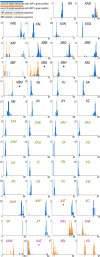Data-driven recombination detection in viral genomes
- PMID: 38632281
- PMCID: PMC11024102
- DOI: 10.1038/s41467-024-47464-5
Data-driven recombination detection in viral genomes
Abstract
Recombination is a key molecular mechanism for the evolution and adaptation of viruses. The first recombinant SARS-CoV-2 genomes were recognized in 2021; as of today, more than ninety SARS-CoV-2 lineages are designated as recombinant. In the wake of the COVID-19 pandemic, several methods for detecting recombination in SARS-CoV-2 have been proposed; however, none could faithfully confirm manual analyses by experts in the field. We hereby present RecombinHunt, an original data-driven method for the identification of recombinant genomes, capable of recognizing recombinant SARS-CoV-2 genomes (or lineages) with one or two breakpoints with high accuracy and within reduced turn-around times. ReconbinHunt shows high specificity and sensitivity, compares favorably with other state-of-the-art methods, and faithfully confirms manual analyses by experts. RecombinHunt identifies recombinant viral genomes from the recent monkeypox epidemic in high concordance with manually curated analyses by experts, suggesting that our approach is robust and can be applied to any epidemic/pandemic virus.
© 2024. The Author(s).
Conflict of interest statement
The authors declare no competing interests.
Figures




References
MeSH terms
Grants and funding
- P2022CNN2J/Ministero dell'Istruzione, dell'Università e della Ricerca (Ministry of Education, University and Research)
- P2022CNN2J/Ministero dell'Istruzione, dell'Università e della Ricerca (Ministry of Education, University and Research)
- P2022CNN2J/Ministero dell'Istruzione, dell'Università e della Ricerca (Ministry of Education, University and Research)
- P2022CNN2J/Ministero dell'Istruzione, dell'Università e della Ricerca (Ministry of Education, University and Research)
LinkOut - more resources
Full Text Sources
Medical
Miscellaneous

